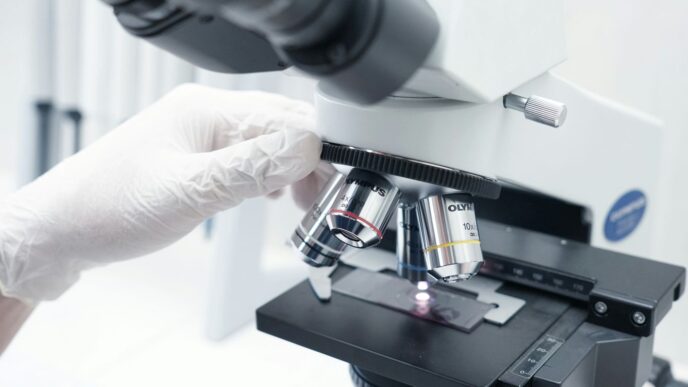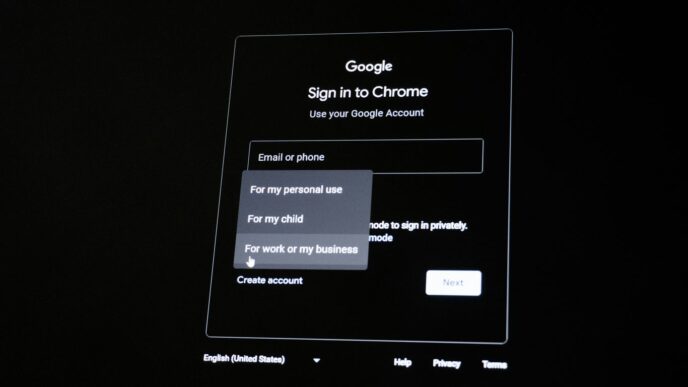Cancer is a tough disease, and finding it early makes a big difference. For a long time, doctors have been looking for better ways to spot cancer sooner. Now, artificial intelligence, or AI, is stepping in. It’s like giving doctors superpowers to see things they couldn’t before. This technology is changing how we find, understand, and treat cancer, making things more precise and hopefully leading to better outcomes for everyone involved. We’re going to look at how AI is shaking things up in cancer diagnostics.
Key Takeaways
- AI is improving how we look at medical images, like mammograms, to find cancer earlier and more accurately, especially in tricky cases like dense breast tissue.
- By looking at lots of patient data, AI can help predict who might get cancer and identify groups that need more attention.
- In digital pathology, AI is helping speed up the work of looking at tissue samples and finding important markers, making diagnoses more reliable.
- AI helps create personalized treatment plans by analyzing genetic information and suggesting the best therapies for each patient.
- AI is also speeding up the discovery of new cancer drugs and helping doctors plan surgeries more precisely.
Advancements in Medical Imaging Diagnostics
Medical imaging has always been a cornerstone of spotting cancer, but AI is really changing the game. Think of it like giving radiologists super-powered glasses. These systems can sift through scans like mammograms, CTs, and MRIs with incredible speed and detail. AI algorithms are getting remarkably good at spotting tiny anomalies that might be missed by the human eye, especially in complex cases. This isn’t just about finding cancer sooner; it’s about finding it more accurately.
Enhanced Sensitivity in Breast Cancer Screening
When it comes to breast cancer, early detection is key. AI is making mammograms even better. These tools can analyze images and flag suspicious areas with a higher degree of certainty. Studies have shown AI models can significantly cut down on both false positives (telling someone they have cancer when they don’t) and false negatives (missing cancer that’s actually there). This means fewer unnecessary biopsies and less chance of a cancer going undetected.
Improved Detection in Dense Breast Tissue
Dense breast tissue can make mammograms tricky to read, as it can hide abnormalities. AI is proving particularly helpful here. By learning the subtle patterns associated with cancer, AI can help radiologists see through the density and identify potential issues that might otherwise be obscured. It’s like having an extra layer of scrutiny specifically designed for these challenging scans.
AI-Assisted Radiographic Interpretation
Radiologists are already experts, but AI acts as a powerful assistant. It can automate parts of the image review process, highlighting areas that warrant closer inspection. This doesn’t replace the radiologist; it augments their capabilities. Imagine a system that pre-sorts scans, prioritizing those with the most concerning findings. This can lead to:
- Faster turnaround times for scan results.
- Reduced workload for radiologists, allowing them to focus on complex cases.
- More consistent interpretations across different readers.
Some AI models are even performing on par with, or better than, experienced radiologists in specific tasks. This technology is rapidly evolving, moving from research labs into everyday clinical practice, promising a future where cancer is caught earlier and more reliably.
The Role of AI in Predictive Analytics
It’s pretty wild how much information is out there about our health, and AI is getting really good at sifting through it all. Think about it – we’re talking about millions of patient records, environmental factors, even our daily habits. AI can look at all that data and spot patterns that a human might completely miss. This is a game-changer for figuring out who might be at risk for certain cancers, sometimes even before any symptoms show up.
Forecasting Disease Incidences
One of the most exciting uses of AI is its ability to predict how likely someone is to develop a specific cancer. For instance, researchers have used AI to look at patient data, including things that don’t seem directly related to cancer, like other illnesses or doctor visits. By analyzing these seemingly unrelated clues, AI models have shown they can predict the risk of developing cancers like pancreatic cancer with surprising accuracy. This is a big deal because it means we might be able to catch these diseases much earlier, when they’re easier to treat.
Identifying High-Risk Patient Populations
Beyond just predicting individual risk, AI can also help us identify entire groups of people who might be more susceptible to certain cancers. This isn’t just about genetics, though that’s part of it. AI can consider a whole mix of factors – where people live, their lifestyle, their medical history – to paint a clearer picture of who needs closer monitoring or earlier screening. This allows healthcare systems to focus their resources where they’re needed most, making prevention efforts more effective.
Uncovering Hidden Health Trends
AI’s ability to process massive amounts of data means it can uncover trends that are really hard to see otherwise. It can connect the dots between things like environmental exposures, dietary patterns, and the development of cancer over time. This kind of insight can lead to new public health strategies and a better understanding of what causes cancer in the first place. By spotting these subtle connections, AI helps us move from just reacting to cancer to actively preventing it.
AI’s Impact on Digital Pathology
Digital pathology is really changing how we look at cancer samples. Instead of just looking down a microscope, we now scan slides into super high-resolution digital images. This opens the door for AI to do some pretty amazing things. AI can help automate the tedious parts of a pathologist’s job, freeing them up to focus on the really complex cases. It’s like having a super-powered assistant that can sift through tons of data way faster than a human ever could.
Automating Pathologist Workflows
Think about how much time pathologists spend just looking at slides, trying to find tiny abnormalities. AI can take on a lot of that grunt work. It can pre-screen slides, flag areas that look suspicious, and even do initial counts of cells. This means less time spent on repetitive tasks and more time for critical thinking and diagnosis. It’s not about replacing pathologists, but about giving them tools to work more efficiently.
Enhancing Diagnostic Accuracy with Digital Slides
When you digitize slides, you get a consistent, high-quality image every time. AI can then analyze these images with incredible detail. It can spot patterns that might be too subtle for the human eye, especially when looking at thousands of cells. This can lead to more accurate diagnoses, reducing the chance of missed findings or misinterpretations. For example, AI has already been approved to help detect prostate cancer in biopsy slides, showing its real-world potential.
Biomarker Detection Innovations
Finding specific biomarkers is key for understanding cancer and choosing the right treatment. Traditional methods can be slow and sometimes not sensitive enough. AI is a game-changer here. It can analyze complex tissue samples to identify and quantify biomarkers with greater speed and precision. Some AI models are even getting good at predicting things like genetic mutations directly from the slide images, which could speed up treatment decisions significantly. However, it’s still early days for some of these predictions, and human oversight remains important to confirm findings.
Precision Medicine and Personalized Treatment
This is where things get really interesting. Instead of a one-size-fits-all approach, precision medicine aims to tailor treatments specifically to each person’s unique biological makeup. Think of it like getting a custom suit versus buying one off the rack – much better fit, right? AI is a huge part of making this happen, especially in cancer care.
Genomic Profiling for Targeted Therapies
Cancer isn’t just one disease; it’s a whole bunch of different ones, and they can even vary from person to person. That’s where looking at the genetic code, or genomics, comes in. AI can sift through massive amounts of genetic data from a patient’s tumor to find specific mutations or markers. These markers can then tell us which targeted therapies are most likely to work for that individual’s cancer. For example, in lung cancer or breast cancer, identifying these genetic fingerprints helps doctors choose drugs that specifically attack the cancer cells with those mutations, often leading to fewer side effects than traditional chemotherapy.
Real-Time Treatment Recommendations
Once we have all this genetic information, what do we do with it? AI can help process it quickly and provide doctors with up-to-the-minute suggestions for treatment. It’s like having a super-smart assistant who can instantly analyze a patient’s genetic profile, compare it against vast databases of research and clinical trials, and then suggest the best course of action. This can speed up decision-making, which is often critical when dealing with cancer. It also means treatments can be adjusted on the fly if the cancer isn’t responding as expected.
Predictive Calculators for Optimal Care
AI isn’t just about what to do now; it’s also about what might happen in the future. By analyzing a patient’s data – including their genetics, medical history, and even lifestyle factors – AI can help create predictive models. These models can estimate:
- The likelihood of a specific treatment being effective.
- The potential for the cancer to return after treatment.
- The risk of developing certain side effects.
This kind of foresight allows doctors and patients to make more informed decisions about treatment plans, focusing on strategies that offer the best chance of success while minimizing risks. It’s all about making the care as effective and safe as possible for each unique patient.
Streamlining Cancer Care with AI

It’s pretty amazing how AI is starting to speed things up in the whole cancer journey. Think about it – from finding new drugs to making surgery better and keeping a closer eye on patients, AI is stepping in to make things more efficient. It’s like having a super-smart assistant that can process tons of information way faster than we ever could.
Accelerating Drug Discovery and Development
Developing new cancer drugs used to take ages, and honestly, a lot of it was trial and error. Now, AI can sift through massive databases of compounds, looking for potential candidates that might work against cancer cells. It can even predict how a drug might interact with the body or if it could be repurposed from treating something else. This means we’re not just guessing anymore; AI helps point us in the right direction, potentially cutting down years of research.
- Identifying promising drug compounds from vast chemical libraries.
- Predicting how a drug will behave in the body.
- Finding new uses for existing medications.
Improving Surgical Precision
When it comes to surgery, especially for something as delicate as cancer, precision is everything. AI is helping surgeons by providing real-time guidance during operations. It can analyze scans and patient data to help map out the best approach, sometimes even controlling robotic surgical tools with incredible accuracy. This can lead to smaller incisions, less damage to healthy tissue, and quicker recovery times for patients. It’s not about replacing surgeons, but giving them better tools to do their job.
Facilitating Patient Monitoring and Management
Keeping track of patients after diagnosis and treatment is a big job. AI can help here too. It can monitor patient data from wearables or electronic health records, flagging any concerning changes that might indicate a problem or a relapse. This allows doctors to intervene much sooner. Plus, AI can help manage appointments, treatment schedules, and even provide personalized support, making the whole process less overwhelming for patients and their families.
| Aspect of Monitoring | AI’s Contribution |
|---|---|
| Early Relapse Detection | Analyzing subtle changes in patient data to flag potential recurrence. |
| Treatment Adherence | Reminding patients about medications and appointments. |
| Remote Patient Tracking | Using data from devices to monitor well-being outside the clinic. |
Addressing Challenges in AI Implementation

So, we’ve talked a lot about how amazing AI can be for spotting cancer early and making treatments better. But, like anything new and powerful, getting it into hospitals and clinics isn’t always a walk in the park. There are definitely some hurdles we need to jump over.
Mitigating Dataset Biases
One of the biggest headaches is making sure the data AI learns from is fair. Think about it: if the data used to train an AI mostly comes from one group of people, the AI might not work as well for others. This can lead to some serious problems, like missing cancer in certain populations or recommending treatments that aren’t quite right for them. We need to be really careful about this.
- Checking the data: Before we even start training an AI, we need to look closely at where the data is coming from. Is it diverse enough? Does it represent different ages, genders, ethnicities, and backgrounds?
- Fixing what’s wrong: If we find bias, we need ways to correct it. This might mean collecting more data from underrepresented groups or using special techniques to adjust the data so the AI learns more balanced patterns.
- Keeping an eye on it: Even after an AI is in use, we can’t just forget about it. We need to keep checking if it’s performing fairly across all patient groups and make adjustments if needed.
Ensuring Regulatory Compliance
Getting new medical technology approved is a whole process, and AI is no different. There are rules and guidelines that AI tools need to follow to make sure they’re safe and effective. This can be tricky because AI technology changes so fast, and the rules are still catching up.
- Clear rules needed: We need clear guidelines from places like the FDA on how to test and approve AI for medical use. This helps everyone know what to expect.
- Transparency is key: Doctors and patients need to understand how an AI tool works, at least to some degree. If an AI makes a recommendation, it’s helpful if we can see why it made that suggestion. This is where things like ‘Explainable AI’ come in, trying to make the AI’s thinking less of a mystery.
- Keeping up with changes: As AI gets better, the regulations will need to adapt. It’s a constant back-and-forth to make sure the rules are still relevant.
Overcoming Cost Barriers
Let’s be real, implementing new technology costs money. Developing AI tools, getting them approved, and then integrating them into existing hospital systems can be a big financial undertaking. This can make it hard for smaller hospitals or clinics to adopt these advanced tools, potentially widening the gap in care quality.
- Showing the value: We need to clearly show how AI can save money in the long run, perhaps by catching diseases earlier when they’re cheaper to treat, or by making existing processes more efficient.
- Finding smart funding: Exploring different ways to fund AI adoption, like grants or partnerships, could help ease the financial burden.
- Making it accessible: As AI tools become more common, we hope their costs will come down, making them more available to a wider range of healthcare providers.
The Road Ahead
So, where does all this leave us? It’s pretty clear that artificial intelligence is shaking things up in the fight against cancer. We’re seeing AI get really good at spotting cancer earlier than ever before, sometimes finding things that might have been missed otherwise. It’s like having an extra pair of super-powered eyes looking at scans and data. But, and it’s a big ‘but’, it’s not a magic wand. We still need to figure out how to make sure the data AI learns from is fair and doesn’t leave anyone out. Plus, getting these tools approved and actually used in hospitals is a whole other puzzle. Still, the potential is huge. AI is helping us move towards treatments that are more tailored to each person, and that’s a really hopeful direction. It’s going to take some work to get there, but the future of cancer detection and treatment looks a lot smarter, thanks to AI.












